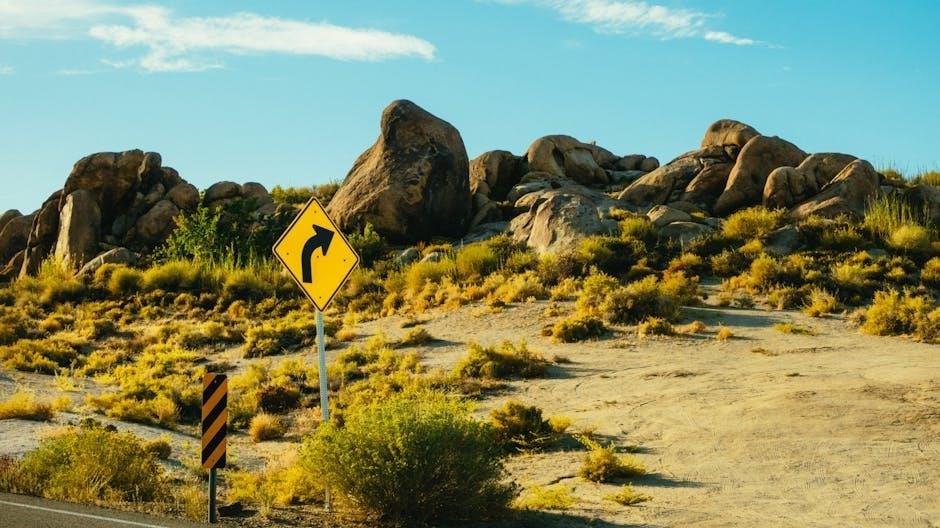Welcome to the Rock Guide, your comprehensive resource for understanding the fascinating world of rocks․ This guide explores their types, formation processes, and significance in nature and human activities, providing essential insights for enthusiasts and adventurers alike․
From igneous to metamorphic, rocks shape our planet’s landscape and play a crucial role in both industrial and recreational contexts․ Discover their importance and how they impact our daily lives and environment․
What is a Rock Guide?
A rock guide is a detailed resource that helps identify, classify, and understand various types of rocks and their characteristics․ It serves as an essential tool for geologists, students, and outdoor enthusiasts, providing insights into the composition, formation, and properties of rocks․ Whether for educational purposes, research, or recreational activities like hiking and climbing, a rock guide offers valuable information to explore and appreciate the geological world․ It often includes practical applications, such as environmental conservation and sustainability tips, making it a comprehensive companion for anyone interested in Earth’s rocky landscapes․
Importance of a Rock Guide for Outdoor Enthusiasts
A rock guide is essential for outdoor enthusiasts, providing critical insights into the geological world․ It helps identify rock types, understand their formation, and navigate diverse terrains safely․ For hikers and climbers, it offers practical information to assess terrain stability and choose secure routes․ Additionally, it fosters a deeper appreciation of nature, enabling enthusiasts to connect with the environment on a more meaningful level․ By promoting awareness of geological features, a rock guide enhances outdoor experiences while encouraging environmental stewardship and sustainable exploration of natural landscapes․

Types of Rocks
Rocks are categorized into three main types: igneous, sedimentary, and metamorphic․ Each type forms through distinct geological processes, shaping the Earth’s surface in unique ways․
Igneous Rocks
Igneous rocks are formed from the cooling and solidification of magma or lava․ They can originate beneath the Earth’s surface (intrusive) or above it (extrusive)․ Granite and basalt are common examples․ Intrusive rocks have large crystals due to slow cooling, whereas extrusive rocks, like obsidian, cool rapidly, resulting in fine-grained or glassy textures․ These rocks are crucial in understanding volcanic activity and the Earth’s thermal processes․ Their study provides insights into the planet’s internal dynamics and geological history, making them vital for both scientific research and practical applications in construction and industry․
Sedimentary Rocks
Sedimentary rocks are formed through the accumulation and compression of mineral particles, organic matter, or rock fragments․ They often develop in layers, reflecting their depositional history․ Common examples include sandstone, shale, and limestone․ These rocks can contain fossils, providing valuable insights into Earth’s history․ The formation process involves erosion, transportation, and deposition of sediments, followed by lithification․ Sedimentary rocks are diverse, ranging from soft, erodible materials like chalk to hard, durable ones like conglomerate․ They are essential for understanding geological history and play a key role in natural resource extraction, such as oil and gas reserves․
Metamorphic Rocks
Metamorphic rocks are transformed from pre-existing igneous, sedimentary, or other metamorphic rocks under high pressure and temperature conditions․ This alteration occurs without melting, reshaping minerals and structures․ Examples include marble, slate, and quartzite․ The process involves recrystallization, creating new textures and mineral compositions, often resulting in striking patterns like foliation․ These rocks provide insights into Earth’s tectonic and thermal history․ They are vital in construction and industry, with uses ranging from countertops to roofing materials․ Their unique beauty and durability make them highly valued in both natural and human-made environments․
Rock Formation Processes
Rock formation involves geological processes like magmatic cooling, sediment accumulation, and metamorphic transformations․ These processes shape Earth’s crust, creating diverse rock types over millions of years․
Geological Processes That Shape Rocks
Geological processes such as plate tectonics, volcanic activity, and weathering play a crucial role in shaping rocks․ These forces create, transform, and erode rock formations over time, influencing Earth’s landscape․ Plate tectonics drive the movement of the Earth’s crust, leading to the creation of mountain ranges and volcanoes․ Volcanic activity produces igneous rocks, while weathering breaks down existing rocks into sediments․ These processes are essential for understanding the dynamic nature of our planet’s geology and the ever-changing rock formations that shape our environment․
Role of Weathering and Erosion
Weathering and erosion are key processes that shape rocks over time․ Weathering breaks down rocks into smaller fragments through mechanical forces, like freezing water, or chemical reactions, such as acid rain․ Erosion then transports these fragments away, often carried by wind, water, or ice․ Together, these processes contribute to the formation of sediments and the reshaping of landscapes․ They play a vital role in creating natural features like canyons, cliffs, and soil, highlighting the dynamic and ever-changing nature of Earth’s geology․
Uses of Rocks
Rocks are vital in construction, manufacturing, and recreation, serving as key resources for human activities and natural exploration․ Their durability and versatility make them indispensable in both industrial and outdoor settings, contributing to progress and environmental shaping․

Industrial Applications of Rocks
Rocks are cornerstone resources in various industries․ They are mined for minerals like iron, copper, and gold, essential for manufacturing and technology; Crushed stone and gravel are widely used in construction for building roads and structures․ Additionally, rocks serve as raw materials for producing cement, glass, and ceramics․ Their durability and versatility make them integral to energy production, with coal and limestone being key components in power generation․ Industrial applications highlight rocks’ significant role in driving economic development and modern infrastructure, showcasing their enduring importance across sectors․ Their extraction and use require sustainable practices to minimize environmental impact․
Recreational Uses of Rocks
Rocks offer diverse opportunities for outdoor enthusiasts․ Rock climbing is a popular activity, attracting adventurers who challenge themselves on natural formations․ Hiking trails often feature scenic rock landscapes, providing breathtaking views․ Collecting unique rocks and minerals has become a hobby for many, fostering an appreciation for geology․ Additionally, rocks are used in landscaping to create decorative gardens and water features․ Their aesthetic and structural versatility makes them integral to both active recreation and serene environments, enhancing the enjoyment of nature and promoting physical and mental well-being through exploration and connection with the earth․

Rock Climbing Safety
Rock climbing safety is crucial for a secure and enjoyable experience․ Always inspect equipment, use proper techniques, and stay aware of environmental conditions to minimize risks effectively․
Essential Tools for Rock Climbing
Rock climbing requires specific gear to ensure safety and efficiency․ A good harness, sturdy ropes, and reliable carabiners are fundamental․ Climbing shoes provide the necessary grip, while chalk bags keep hands dry․ A helmet is crucial for protecting against falling debris or head injuries․ Belay devices and ascenders are vital for controlling descents and emergencies․ Additionally, a first-aid kit and communication devices like two-way radios are essential for remote climbs․ Proper tools not only enhance performance but also minimize risks, making every climb safer and more enjoyable for climbers of all skill levels․
Safety Tips for Beginners
For novice climbers, safety is paramount․ Always inspect equipment before use and ensure proper fit․ Climb with an experienced partner or guide to learn techniques and emergencies․ Start with easier routes to build confidence and skill․ Learn basic knots and belaying procedures thoroughly․ Stay focused and communicate clearly with your partner․ Avoid climbing when fatigued or distracted․ Test all gear before relying on it․ Warm up with lighter exercises to prevent injuries․ Respect your limits and the environment․ Adhering to these guidelines helps ensure a safe and enjoyable climbing experience for all levels․

Environmental Impact
Rock climbing and exploration can impact ecosystems, causing erosion and damaging habitats․ Human activity must be balanced with sustainable practices to preserve natural beauty for future generations․
How Rock Climbing Affects the Environment
Rock climbing can significantly impact the environment, leading to soil erosion and vegetation damage near climbing routes․ The repetitive use of chalk by climbers can accumulate on rocks, affecting plant growth․ Additionally, the removal of natural rock formations and disturbance of wildlife habitats can disrupt local ecosystems․ Climbing gear and human activity may also contribute to litter and environmental degradation․ It is crucial for climbers to adopt mindful practices to minimize their ecological footprint while enjoying nature․
Best Practices for Sustainable Rock Climbing
To minimize environmental impact, climbers should adhere to sustainable practices․ Avoid removing or altering natural rock features, and refrain from using excessive chalk, which can harm plant growth․ Stay on designated trails to prevent soil erosion and protect vegetation․ Dispose of waste properly and avoid littering․ Respect wildlife habitats and nesting areas․ Use eco-friendly climbing gear and avoid disturbing sensitive ecosystems․ Participate in local clean-up initiatives and promote environmental awareness within the climbing community․ By adopting these practices, climbers can help preserve natural beauty for future generations while enjoying their passion responsibly․
Rocks are integral to Earth’s structure and human activities, offering insights into nature’s history․ Responsible exploration and sustainable practices ensure their preservation for future generations to appreciate and study․
Final Thoughts on Rock Climbing and Exploration
Rock climbing and exploration are transformative experiences that connect us with nature and challenge our limits․ They foster personal growth, resilience, and a deeper appreciation for Earth’s geological wonders․
Safety and environmental respect are paramount to ensure sustainable adventures․ By embracing responsible practices, climbers can preserve these natural treasures for future generations․
The thrill of conquering peaks and uncovering hidden landscapes is unparalleled, making rock climbing a rewarding pursuit for outdoor enthusiasts․ Adventure awaits, but so does the duty to protect our planet․




